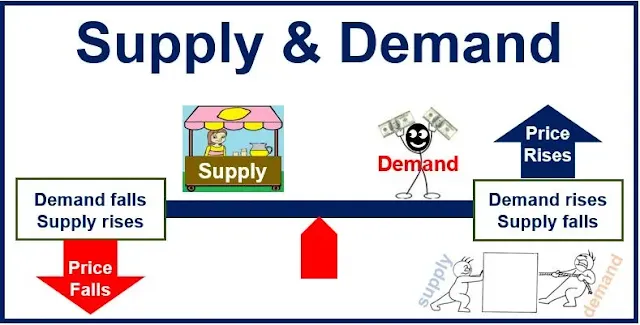Ad Code
Translate
Smart strategies for trading on crypto exchanges
October 20, 2025
Five Do’s For a Healthy Turnover That Bolsters Talent-Retention
October 20, 2025
Discover Honeybee Pharmacy (2025 Guide Important Consumer Tips)
October 14, 2025
What is Ozempic (semaglutide)? (Updated in 2025)
January 30, 2025
Posture Bra: Improving Back Support and Comfort
October 20, 2025
How To Find Suitable Properties In Cyprus?
October 20, 2025
10 Effective Strategies to Improve Domain Authority of Your Website
October 20, 2025
Demand Planning: What It Is and Why It Matters
Zizo Gala-Mkhize
April 12, 2022

Any company that sells anything knows that demand fluctuates throughout the year. Sometimes, demand is high. Other times, it’s low. And sometimes, it falls right in between.
Companies that sell multiple products also know that the demand for each type of item will vary. For example, a company that sells outdoor sporting equipment knows that jet skis and swimming pools will be in higher demand in the warm months, while snow skis and boots will be popular in colder months.
This knowledge is common, but not every company knows exactly how to put it to use in the most useful way. However, being able to utilize that knowledge through effective demand planning is an important aspect of business success.
It prevents your company from spending more money than necessary on the resources you need to meet demand at the last minute.
It’s important to remember that there are always things that can’t be accounted for and unexpected events that occur. For example, no one expects to be hit by a global pandemic. Such a thing is unforeseeable, so you don’t have much control at those times.
Demand planning may not be able to address such unexpected issues, but it can certainly help you address the foreseeable ones and prevent unnecessary delays.
Companies that sell multiple products also know that the demand for each type of item will vary. For example, a company that sells outdoor sporting equipment knows that jet skis and swimming pools will be in higher demand in the warm months, while snow skis and boots will be popular in colder months.
This knowledge is common, but not every company knows exactly how to put it to use in the most useful way. However, being able to utilize that knowledge through effective demand planning is an important aspect of business success.
- Demand planning is a process through which companies take historical sales data, customer trends, and seasonal traits into account. With this information, you can make an accurate sales forecast and a plan to meet that demand. Taking the time to do this provides the following benefits.
- Demand planning helps ensure you have the inventory you need when you need it, keeping your customers satisfied and coming back for more.
- It prevents you from keeping too much inventory on the shelf, which locks up your capital.
It prevents your company from spending more money than necessary on the resources you need to meet demand at the last minute.
It’s important to remember that there are always things that can’t be accounted for and unexpected events that occur. For example, no one expects to be hit by a global pandemic. Such a thing is unforeseeable, so you don’t have much control at those times.
Demand planning may not be able to address such unexpected issues, but it can certainly help you address the foreseeable ones and prevent unnecessary delays.
Tips for Getting Started
If you’re new to demand planning, it can seem a little overwhelming as you’re not sure where to start.These tips can help.
Get the Tools You Need
One of the most helpful tools you can have is demand planning software. It is incredibly effective at helping you organize your data, create sales forecasts, and develop a plan to help you meet your demand.
Form a Team
In order to plan for demand and gather the relevant data, you need input from people in various departments of your company. Everyone will have some essential information that needs to be accounted for.You should all work together to determine which data is the most relevant and how it should be prioritized. And to keep everything running smoothly, each member of the team should play and understand their role in ongoing demand planning.
Assess Your System and Adjust As Necessary
Nothing will be perfect the first time around, and needs will change over time. That’s why it’s imperative that your team meet regularly to discuss the success of your demand planning system. If things are not running as smoothly as they should, you’ll need to work together to adjust your relevant data and your system.Remember, demand planning is essential, but it’s not a one-time thing. You’ll need software, a system that can be adjusted as needed, and a team committed to success.
Featured Post
DL Mining Launches Ethereum Contract Participation Service, Helping Users Earn $2K Stable Daily Returns
Zizo Gala-Mkhize-
October 20, 2025
Soapie Teasers
Sister Sites
Most Popular
List of 6,000+ Dofollow Commentluv Blogs FREE (Updated 2025)
January 16, 2025
Five Do’s For a Healthy Turnover That Bolsters Talent-Retention
October 20, 2025
How To Choose The Right Place For A Winter Campsite
March 06, 2023
Popular posts
List of 6,000+ Dofollow Commentluv Blogs FREE (Updated 2025)
January 16, 2025
Five Do’s For a Healthy Turnover That Bolsters Talent-Retention
October 20, 2025
What is Ozempic (semaglutide)? (Updated in 2025)
January 30, 2025
Footer Menu Widget
Created By Blogspot Theme | Distributed By Gooyaabi Templates

Social Plugin